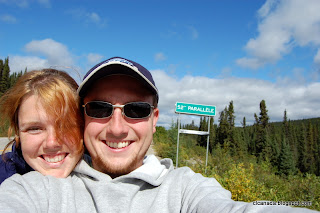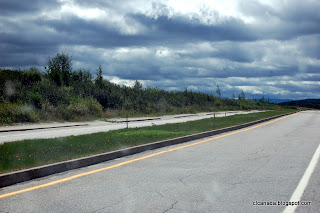Leaving Labrador City, we made the crossing into a new province. The change was immediate as all the signs went from English to French. Stopping in the mining town of Fermont, we sought out the visitor center and stopped to gawk at a mining truck they have converted into a park decoration.
 |
| Can you spot Carl in this picture? |
Back on the road, we were shocked to see the Mt. Wright mining effort. There is an entire mountain being strip mined and moved around right near the highway. The most shocking thing to me was the red muddy river that flowed through this area. It was the first contaminated water we had since in days, maybe on this entire trip, and the color was so brown you could not process that it was actually a body of water.
There are several moved or abandoned mining projects in this region. Every now and then we would spot old signs and structures like silos. We also kept an eye out for the ghost town of Gagnon. This mining town was operational until around 1985 when the entire town was sold off and dismantled. Driving down the dirt road, we suddenly encountered a paved road with a median, curb and sidewalk. There were even manholes in the road. There is no way to fully describe the eerie feeling of coming across the infrastructure for a thriving suburbia in the middle of absolute wilderness. Somewhere during this time, we also crossed the 52nd parallel.
Shortly after the “town” of Relias Gabriel we pulled off on a path that lead down to the water. The reservoir here is part of the giant Manic-5 dam complex that we would encounter later in the day. It is also the remnant of a pre-Cambrian meteor crash which gives the region its shape.
After kilometers of gravel, we finally found the paved road. About this time we also caught our first glance of the Manic-5 dam. The roadway originally drove across the top of this structure, but in recent years they have re-routed the road to weave down beside the dam. Still, it was impressive. The sheer size of the structure is overwhelming. Pictures do not do it justice.
While preparing for this trip, my research had shown that tours of the dam were given during the “Summer;” it turns out that the Summer season ends on August 31, and here we are on September 3... Another Dam Tour missed by just a few days.
We had originally planned to camp near Manic-5, but since Relias Gabriel turned out to be nothing but a gas station and there was no tour to take up our time, we decided to push on and make up a day in our itinerary. Arriving in the outskirts of Baie-Comeau, we stopped at the Manic-2 camping grounds. As soon as we saw that EVERY sign on the property was in French, we knew that we were in for an interesting night. Thankfully, there is one staff member who does speak a bit of broken English and between that and the use of my Driver’s License, we were able to fill out the registration form; of course, they think my name is Marie Lindi.
So here we are, in the middle of Quebec, knowing next to no French and camping with an entirely French speaking crowd…. And we are having a blast. Tonight there is a huge bonfire, complete with a burning picnic table, and a concert in the public tent. I have already heard the French version of “Down on the Corner.”





























































